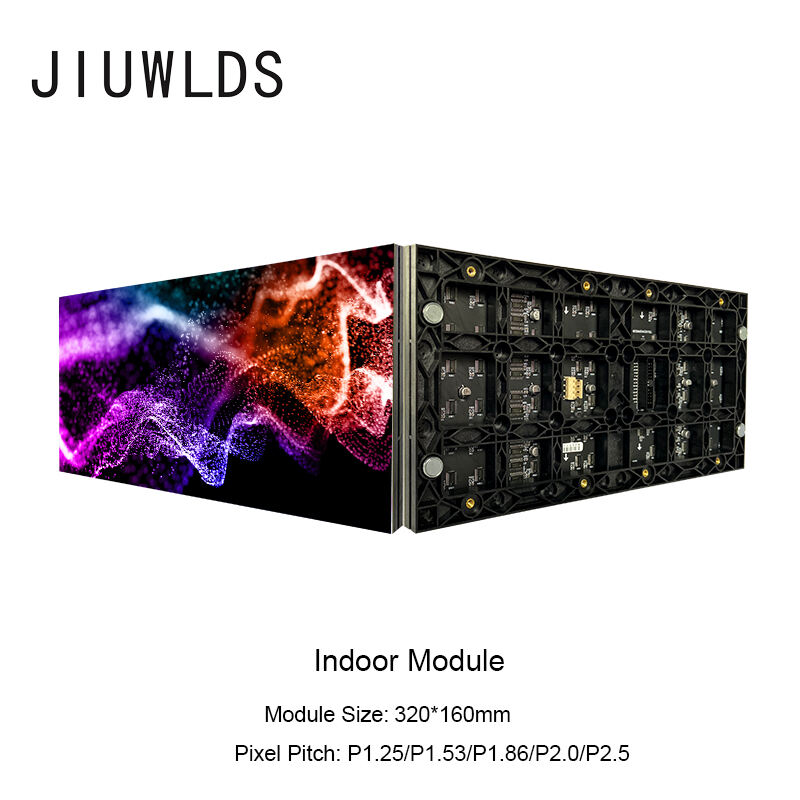Digital Signage Displays: Enhancing Customer Engagement in Commercial Spaces
The Role of Digital Signage in Modern Customer Engagement
Why Digital Signage Outperforms Traditional Media
Digital signage outshines traditional media by providing real-time updates and dynamic content, significantly enhancing engagement in high-traffic environments. Unlike static displays, digital signage offers vibrant visuals and animations that capture consumer attention effectively. Studies from various marketing research firms show that 70% of consumers feel more engaged with digital signage compared to traditional static displays. This heightened engagement translates to increased foot traffic, as 80% of consumers are attracted to interactive displays within retail settings. The ability to update content instantly and tailor it to specific consumer demographics makes digital signage an indispensable tool for modern marketers. Whether it's through interactive elements or eye-catching animations, the technology ensures a memorable and engaging consumer experience.
Key Metrics: Attention Retention and Brand Recall
Digital signage is remarkably effective at improving brand recall and attention retention. Research shows it can boost brand recall rates by up to 46% compared to traditional advertising methods. Various metrics, such as dwell time and viewer analytics, measure the effectiveness of digital signage, providing valuable insights for refining marketing campaigns. Additionally, recent studies confirm that targeted digital signage campaigns lead to significantly higher retention of promotional messages among customers. Metrics like social media engagement and sales conversion rates also track its effectiveness. With these tools, businesses can adjust campaigns to enhance their reach and resonance, ensuring their branding efforts are consistently impactful. This strategic advantage makes digital signage a powerful component in achieving marketing goals.
AI-Driven Digital Signage Solutions Transforming Commercial Spaces
Smart Content Personalization with Machine Learning
Machine learning algorithms are revolutionizing digital signage by dynamically personalizing content to maximize viewer engagement. By analyzing viewer data, these systems ensure that content is not only relevant but highly engaging, leading to a reported 30% improvement in user engagement metrics by companies using AI-driven digital signage. This personalization can be based on demographics, time of day, or other parameters, allowing businesses to tailor their marketing strategies effectively. The real-time adaptability of digital signage ensures messages reach the audience precisely when they are most receptive, optimizing reach and impact.
Case Study: NVIDIA's Retail AI Adoption Insights
NVIDIA’s integration of AI into retail environments has provided substantial benefits in customer interactions and sales performance. By employing tailored promotions derived from foot traffic analytics, NVIDIA saw measurable increases in both shopper retention and sales conversion rates. An interesting finding from their study indicated over a 20% increase in customer inquiries about featured products showcased through AI-driven displays. The insights gained from comprehensive AI analytics have given retailers actionable data to refine their marketing strategies continuously, illustrating the powerful role AI can play in enhancing retail success.
Automated Analytics for Real-Time Campaign Adjustments
Modern digital signage solutions leverage automated analytics to fine-tune marketing campaigns in real-time, catering to audience preferences and reactions. Businesses now have the capability to adjust messaging strategies in seconds, resulting in notably improved conversion rates. These systems can identify trends in viewer interaction, allowing marketers to rapidly change their approach. This level of responsiveness bolsters sales figures, especially during peak times when customer traffic is at its highest, highlighting how automated analytics can translate into greater business success.
Energy-Efficient Displays: Sustainability Meets Functionality
Samsung Color E-Paper: Zero-Power Static Displays
Samsung Color E-Paper technology is a cutting-edge innovation that offers a sustainable alternative for static displays by leveraging e-ink technology. This zero-power solution is ideal for environments needing prolonged content display with a strong emphasis on energy efficiency. Implementing these displays promotes a significant reduction in energy costs and carbon footprints, making them appealing to eco-conscious businesses. Research shows that businesses adopting zero-power technology can save up to 50% on energy bills compared to traditional digital signage. As companies look for greener solutions, Samsung's Color E-Paper is setting new standards in making digital signage both functional and sustainable. For more information, see Samsung Color E-Paper.
Recycled Materials in Digital Signage Manufacturing
Sustainability in digital signage isn't limited to energy-efficient technology; it extends to the materials used in manufacturing. Many digital signage vendors, including those utilizing Samsung solutions, are increasingly incorporating recycled components into their products. Utilizing environmentally friendly materials not only reduces waste but appeals to eco-conscious consumers, contributing to a 15% increase in customer loyalty and brand trust according to various studies. This move towards sustainable practices not only enhances a company's brand image in competitive markets but also aligns with the growing demand for environmentally responsible business strategies. Embracing recycled materials in manufacturing is a step towards building a greener future for all.
Industry-Specific Applications of Digital Signage
Retail: Dynamic Pricing and Interactive Product Showcases
Digital signage is revolutionizing the retail industry by allowing retailers to embrace dynamic pricing strategies that respond to real-time market data and customer demand fluctuations. This flexibility empowers retailers to tailor pricing based on competitive landscape and immediate consumer trends, enhancing profitability. Additionally, interactive displays engage customers uniquely, promoting a 12% increase in purchases in environments enriched by dynamic visuals. Such displays also enable the showcasing of real-time inventory, improving customer experiences and fostering informed decision-making. Case studies consistently demonstrate that strategically-placed digital signage boosts impulsive buying behaviors, turning casual shoppers into committed buyers. Retailers seeking a cutting-edge approach to customer engagement should explore digital signage solutions for optimal results.
Healthcare: Reducing Wait-Time Anxiety with Real-Time Updates
Utilizing digital signage in healthcare settings addresses wait-time anxiety by providing patients with real-time updates regarding their wait status and available services. Research highlights improved satisfaction levels among patients when real-time updates complement the traditional waiting experience, leading to calmer, more informed visitors. These updates significantly enhance the flow of information within medical facilities, contributing to superior patient experiences across the board. Furthermore, many healthcare providers integrate educational content with wait-time information, enriching patient understanding of available services while waiting. For healthcare systems prioritizing patient satisfaction, upgrading to digital signage solutions should be considered an essential move.
Corporate: Microsoft Teams Integration for Workplace Collaboration
Incorporating digital signage with platforms like Microsoft Teams fosters impactful communication within corporate environments, optimizing collaboration. Companies who have adopted these integrations report a remarkable 40% reduction in meeting times, driven by enhanced project collaboration facilitated by digital tools. Besides improving communication, digital screens serve to display internal updates transparently, nurturing a culture of openness. Studies indicate higher employee engagement and satisfaction levels in organizations using robust, integrated digital communication solutions. Businesses interested in elevating teamwork and transparency can benefit greatly from considering digital signage options that work seamlessly with existing communication infrastructures.
Future Trends in Digital Signage Technology
Augmented Reality Integration in Wayfinding Systems
The integration of augmented reality (AR) in digital signage is transforming wayfinding in complex environments like airports and malls, offering users an advanced navigation experience. AR technology facilitates interactive maps and real-time directional cues that significantly improve user experience by making navigation more intuitive and streamlined. Studies indicate that AR can increase navigation speed by up to 30%, leading to enhanced overall customer satisfaction. This cutting-edge application of digital signage has also been noted to increase levels of user engagement, with individuals spending more time interacting with AR content, opening opportunities for businesses to connect with customers in new dynamic ways.
Predictive AI for Hyperlocal Content Delivery
Predictive AI is poised to revolutionize digital signage by enabling hyperlocal content delivery tailored to meet specific community needs. By leveraging local data, businesses can significantly enhance the relevance of advertising, boosting engagement rates potentially by over 25%. The interactivity provided by predictive AI allows for experiences personalized according to audience feedback and behavior analytics, making each interaction more meaningful. Implementing such technology enables brands to gain a competitive edge in local markets by directly addressing the nuanced preferences and requirements of their consumer base, fostering a stronger connection and encouraging repeat engagements.
5G-Enabled Ultra-HD Video Walls
The emergence of 5G technology promises to usher in a new era for digital signage through ultra-HD video walls capable of delivering high-resolution content seamlessly, with no lag, enhancing visual clarity in high-traffic areas. This advancement is expected to significantly enhance the engagement of digital signage by offering richer content experiences specifically tailored to target demographics. Predictions suggest that the utilization of 5G will amplify customer engagement by providing more immersive visual experiences while reducing loading times, thus ensuring real-time updates and smoother interactions. For companies, leveraging 5G-enabled signage means better connectivity and efficacy, which translates to improved customer attraction and retention rates.







 Hot News
Hot News